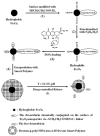Targeting strategies for multifunctional nanoparticles in cancer imaging and therapy
- PMID: 22272217
- PMCID: PMC3263514
- DOI: 10.7150/thno.3463
Targeting strategies for multifunctional nanoparticles in cancer imaging and therapy
Abstract
Nanomaterials offer new opportunities for cancer diagnosis and treatment. Multifunctional nanoparticles harboring various functions including targeting, imaging, therapy, and etc have been intensively studied aiming to overcome limitations associated with conventional cancer diagnosis and therapy. Of various nanoparticles, magnetic iron oxide nanoparticles with superparamagnetic property have shown potential as multifunctional nanoparticles for clinical translation because they have been used asmagnetic resonance imaging (MRI) constrast agents in clinic and their features could be easily tailored by including targeting moieties, fluorescence dyes, or therapeutic agents. This review summarizes targeting strategies for construction of multifunctional nanoparticles including magnetic nanoparticles-based theranostic systems, and the various surface engineering strategies of nanoparticles for in vivo applications.
Keywords: Multifunctional nanoparticles; bioconjugation; long circulation; magnetic nanoparticles; surface engineering; targeting ligand.
Conflict of interest statement
Conflict of Interest: The authors have declared that no conflict of interest exists.
Figures


















Similar articles
-
Multifunctional magnetic iron oxide nanoparticles: an advanced platform for cancer theranostics.Theranostics. 2020 May 15;10(14):6278-6309. doi: 10.7150/thno.42564. eCollection 2020. Theranostics. 2020. PMID: 32483453 Free PMC article. Review.
-
Surface-engineered magnetic nanoparticle platforms for cancer imaging and therapy.Acc Chem Res. 2011 Oct 18;44(10):883-92. doi: 10.1021/ar200044b. Epub 2011 May 6. Acc Chem Res. 2011. PMID: 21548618 Free PMC article.
-
Targeting strategies for superparamagnetic iron oxide nanoparticles in cancer therapy.Acta Biomater. 2020 Jan 15;102:13-34. doi: 10.1016/j.actbio.2019.11.027. Epub 2019 Nov 20. Acta Biomater. 2020. PMID: 31759124 Review.
-
Multifunctional Iron Oxide Magnetic Nanoparticles for Biomedical Applications: A Review.Materials (Basel). 2022 Jan 10;15(2):503. doi: 10.3390/ma15020503. Materials (Basel). 2022. PMID: 35057223 Free PMC article. Review.
-
Multifunctional Nanomaterials and Their Applications in Drug Delivery and Cancer Therapy.Nanomaterials (Basel). 2015 Oct 14;5(4):1690-1703. doi: 10.3390/nano5041690. Nanomaterials (Basel). 2015. PMID: 28347089 Free PMC article. Review.
Cited by
-
Spherical nucleic acid targeting microRNA-99b enhances intestinal MFG-E8 gene expression and restores enterocyte migration in lipopolysaccharide-induced septic mice.Sci Rep. 2016 Aug 19;6:31687. doi: 10.1038/srep31687. Sci Rep. 2016. PMID: 27538453 Free PMC article.
-
Curcumin nanomedicine: a road to cancer therapeutics.Curr Pharm Des. 2013;19(11):1994-2010. doi: 10.2174/138161213805289219. Curr Pharm Des. 2013. PMID: 23116309 Free PMC article.
-
Nanotechnology for cancer treatment.Nanotechnol Rev. 2015 Apr;3(2):111-122. doi: 10.1515/ntrev-2013-0013. Nanotechnol Rev. 2015. PMID: 26082884 Free PMC article.
-
Erythropoietin improves the accumulation and therapeutic effects of carboplatin by enhancing tumor vascularization and perfusion.Theranostics. 2015 May 1;5(8):905-18. doi: 10.7150/thno.11304. eCollection 2015. Theranostics. 2015. PMID: 26000061 Free PMC article.
-
Nanomaterial-based contrast agents.Nat Rev Methods Primers. 2023;3:30. doi: 10.1038/s43586-023-00211-4. Epub 2023 Apr 13. Nat Rev Methods Primers. 2023. PMID: 38130699 Free PMC article.
References
-
- Boyle P, Levin B. World Cancer Report. World Health Organization Press. 2008.
-
- Jemal A, Siegel R, Xu J, Ward E. Cancer statistics. CA Cancer J Clin. 2010;60:277–300. - PubMed
-
- Maeda H. The enhanced permeability and retention (EPR) effect in tumor vasculature: the key role of tumor-selective macromolecular drug targeting. Adv Enzyme Regul. 2001;41:189–207. - PubMed
-
- Allen TM. Ligand-targeted therapeutics in anticancer therapy. Nat Rev Cancer. 2002;2:705–63. - PubMed
-
- Torchilin VP. Nanoparticulates as drug carriers. Imperial college press. 2006.
LinkOut - more resources
Full Text Sources
Other Literature Sources

